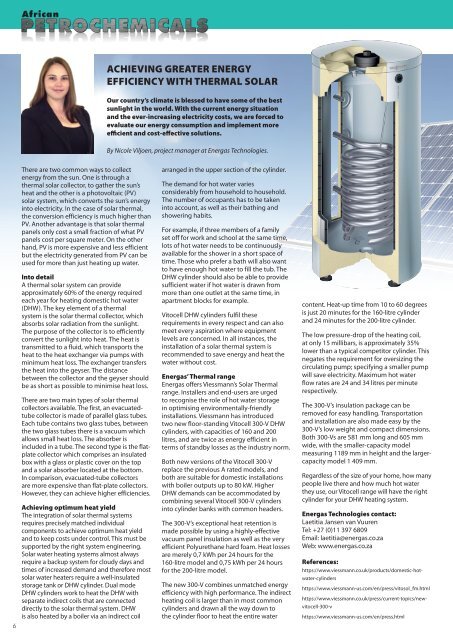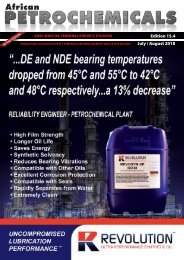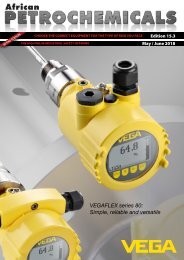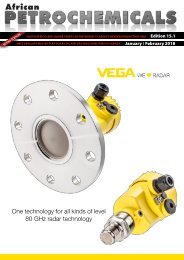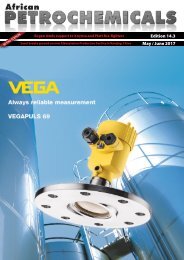African Petrochemicals- 16.1 2019
Create successful ePaper yourself
Turn your PDF publications into a flip-book with our unique Google optimized e-Paper software.
ACHIEVING GREATER ENERGY<br />
EFFICIENCY WITH THERMAL SOLAR<br />
Our country’s climate is blessed to have some of the best<br />
sunlight in the world. With the current energy situation<br />
and the ever-increasing electricity costs, we are forced to<br />
evaluate our energy consumption and implement more<br />
efficient and cost-effective solutions.<br />
By Nicole Viljoen, project manager at Energas Technologies.<br />
6<br />
There are two common ways to collect<br />
energy from the sun. One is through a<br />
thermal solar collector, to gather the sun’s<br />
heat and the other is a photovoltaic (PV)<br />
solar system, which converts the sun’s energy<br />
into electricity. In the case of solar thermal,<br />
the conversion efficiency is much higher than<br />
PV. Another advantage is that solar thermal<br />
panels only cost a small fraction of what PV<br />
panels cost per square meter. On the other<br />
hand, PV is more expensive and less efficient<br />
but the electricity generated from PV can be<br />
used for more than just heating up water.<br />
Into detail<br />
A thermal solar system can provide<br />
approximately 60% of the energy required<br />
each year for heating domestic hot water<br />
(DHW). The key element of a thermal<br />
system is the solar thermal collector, which<br />
absorbs solar radiation from the sunlight.<br />
The purpose of the collector is to efficiently<br />
convert the sunlight into heat. The heat is<br />
transmitted to a fluid, which transports the<br />
heat to the heat exchanger via pumps with<br />
minimum heat loss. The exchanger transfers<br />
the heat into the geyser. The distance<br />
between the collector and the geyser should<br />
be as short as possible to minimise heat loss.<br />
There are two main types of solar thermal<br />
collectors available. The first, an evacuatedtube<br />
collector is made of parallel glass tubes.<br />
Each tube contains two glass tubes, between<br />
the two glass tubes there is a vacuum which<br />
allows small heat loss. The absorber is<br />
included in a tube. The second type is the flatplate<br />
collector which comprises an insulated<br />
box with a glass or plastic cover on the top<br />
and a solar absorber located at the bottom.<br />
In comparison, evacuated-tube collectors<br />
are more expensive than flat-plate collectors.<br />
However, they can achieve higher efficiencies.<br />
Achieving optimum heat yield<br />
The integration of solar thermal systems<br />
requires precisely matched individual<br />
components to achieve optimum heat yield<br />
and to keep costs under control. This must be<br />
supported by the right system engineering.<br />
Solar water heating systems almost always<br />
require a backup system for cloudy days and<br />
times of increased demand and therefore most<br />
solar water heaters require a well-insulated<br />
storage tank or DHW cylinder. Dual mode<br />
DHW cylinders work to heat the DHW with<br />
separate indirect coils that are connected<br />
directly to the solar thermal system. DHW<br />
is also heated by a boiler via an indirect coil<br />
arranged in the upper section of the cylinder.<br />
The demand for hot water varies<br />
considerably from household to household.<br />
The number of occupants has to be taken<br />
into account, as well as their bathing and<br />
showering habits.<br />
For example, if three members of a family<br />
set off for work and school at the same time,<br />
lots of hot water needs to be continuously<br />
available for the shower in a short space of<br />
time. Those who prefer a bath will also want<br />
to have enough hot water to fill the tub. The<br />
DHW cylinder should also be able to provide<br />
sufficient water if hot water is drawn from<br />
more than one outlet at the same time, in<br />
apartment blocks for example.<br />
Vitocell DHW cylinders fulfil these<br />
requirements in every respect and can also<br />
meet every aspiration where equipment<br />
levels are concerned. In all instances, the<br />
installation of a solar thermal system is<br />
recommended to save energy and heat the<br />
water without cost.<br />
Energas’ Thermal range<br />
Energas offers Viessmann’s Solar Thermal<br />
range. Installers and end-users are urged<br />
to recognise the role of hot water storage<br />
in optimising environmentally-friendly<br />
installations. Viessmann has introduced<br />
two new floor-standing Vitocell 300-V DHW<br />
cylinders, with capacities of 160 and 200<br />
litres, and are twice as energy efficient in<br />
terms of standby losses as the industry norm.<br />
Both new versions of the Vitocell 300-V<br />
replace the previous A rated models, and<br />
both are suitable for domestic installations<br />
with boiler outputs up to 80 kW. Higher<br />
DHW demands can be accommodated by<br />
combining several Vitocell 300-V cylinders<br />
into cylinder banks with common headers.<br />
The 300-V’s exceptional heat retention is<br />
made possible by using a highly-effective<br />
vacuum panel insulation as well as the very<br />
efficient Polyurethane hard foam. Heat losses<br />
are merely 0,7 kWh per 24 hours for the<br />
160-litre model and 0,75 kWh per 24 hours<br />
for the 200-litre model.<br />
The new 300-V combines unmatched energy<br />
efficiency with high performance. The indirect<br />
heating coil is larger than in most common<br />
cylinders and drawn all the way down to<br />
the cylinder floor to heat the entire water<br />
content. Heat-up time from 10 to 60 degrees<br />
is just 20 minutes for the 160-litre cylinder<br />
and 24 minutes for the 200-litre cylinder.<br />
The low pressure-drop of the heating coil,<br />
at only 15 millibars, is approximately 35%<br />
lower than a typical competitor cylinder. This<br />
negates the requirement for oversizing the<br />
circulating pump; specifying a smaller pump<br />
will save electricity. Maximum hot water<br />
flow rates are 24 and 34 litres per minute<br />
respectively.<br />
The 300-V’s insulation package can be<br />
removed for easy handling. Transportation<br />
and installation are also made easy by the<br />
300-V’s low weight and compact dimensions.<br />
Both 300-Vs are 581 mm long and 605 mm<br />
wide, with the smaller-capacity model<br />
measuring 1189 mm in height and the largercapacity<br />
model 1 409 mm.<br />
Regardless of the size of your home, how many<br />
people live there and how much hot water<br />
they use, our Vitocell range will have the right<br />
cylinder for your DHW heating system.<br />
Energas Technologies contact:<br />
Laetitia Jansen van Vuuren<br />
Tel: +27 (0)11 397 6809<br />
Email: laetitia@energas.co.za<br />
Web: www.energas.co.za<br />
https://www.viessmann-us.com/en/press/vitosol_fm.html<br />
References:<br />
https://www.viessmann.co.uk/products/domestic-hotwater-cylinders<br />
https://www.viessmann.co.uk/press/current-topics/newvitocell-300-v<br />
https://www.viessmann-us.com/en/press.html


